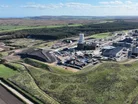Focus on: Polyhalite, a Fertiliser Mineral of the Future

Anglo American has been hit with a $1.6bn writedown in the value of a UK mine that was set to become the world’s biggest polyhalite fertiliser operation.
The mine was set to become operational by 2027, but this has now likely to be 2030, Anglo’s CEO Duncan Wanblad has said. The decision on whether to proceed with the project will depend on results of a feasibility due to be completed at the start of 2025, the company said.
The Woodsmith Mine is a 23-mile long tunnel that will stretch across North Yorkshire in northeastern England. The mine is expected to have a life of 100 years and is the biggest mining project in Britain for decades, and is expected to generate over £100 billion for the UK economy over a period of 50 years.
The mine is set eventually to produce a type of fertiliser designed to improve crop yield but which is not yet proven at scale.
In light of this news, we take a look at this little-known mineral.
What is Polyhalite?
Polyhalite is a mineral composed of potassium, calcium, magnesium and sulphate. It occurs in marine evaporite deposits – rocks composed mostly of minerals produced by evaporation of saline solutions – formed by the evaporation of ancient seas.
Significant deposits have been discovered in the Zechstein Basin, which extends across parts of northern Europe, including Germany, Poland, and the United Kingdom.
In the UK, a substantial polyhalite resource is located in North Yorkshire, beneath the North York Moors National Park.
The mineral was first discovered in 1818 in Austria.
How is Polyhalite mined?
Polyhalite is typically mined using underground methods, because it usually lies deep in geological formations. The extraction process often involves shaft mining, where vertical shafts are sunk from the surface to reach the mineral deposit.
Once brought to the surface, the raw polyhalite undergoes processing to remove impurities and prepare it for use as a fertiliser. This may involve crushing, screening, and in some cases, granulation to produce a product suitable for agricultural applications.
Which countries are the main producers of Polyhalite?
Anglo American's Woodsmith Mine in North Yorkshire was set to be a major source of polyhalite. The US produces polyhalite on a smaller scale. The Intrepid Potash mine in New Mexico has annual production figures of approximately 200,000 to 300,000 tonnes of polyhalite, which is marketed under the brand name Intrepid Trio.
Is polyhalite better than potash?
Polyhalite and potash are both used as fertilisers in agriculture. Potash typically refers to potassium-containing minerals used in fertilisers, with potassium chloride the most common form. Polyhalite, on the other hand, is a naturally occurring mineral that contains potassium, magnesium, calcium, and sulphur.
The main distinction is in their nutrient content. Potash fertilisers generally have a higher concentration of potassium, with grades ranging from 60% to 62% potassium oxide equivalent.
Polyhalite contains a lower potassium content, typically around 14% potassium oxide equivalent, but offers additional nutrients in a single mineral.
In terms of production, potash has a longer history of large-scale mining and global trade. Major potash-producing countries include Canada, Russia, and Belarus.
Potash has an established global market with well-defined pricing mechanisms. The polyhalite market is less mature, with pricing often linked to its nutrient content relative to other fertilisers.
Environmental considerations also factor into the comparison. Some agronomists argue that polyhalite's lower chloride content compared to traditional potash may be beneficial in certain soil conditions.




